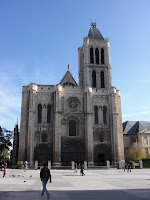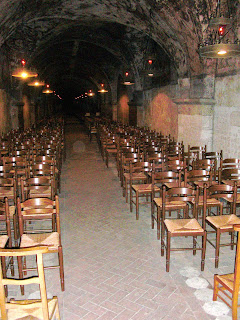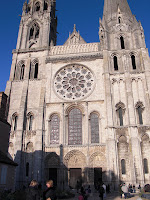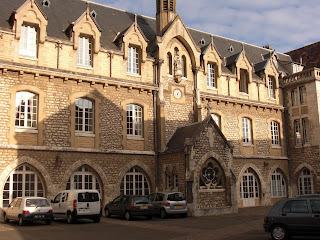 "I never weary of great churches. It is my favorite kind of mountain scenery. Mankind was never so happily inspired as when it made a cathedral." - Robert Louis Stevenson, Scottish poet and author (1850-1894)
"I never weary of great churches. It is my favorite kind of mountain scenery. Mankind was never so happily inspired as when it made a cathedral." - Robert Louis Stevenson, Scottish poet and author (1850-1894)I start the day in the hustle and bustle of modern-day Paris and work my way back a millenium. My mission today is to get up to the north edge of Paris and visit Saint-Denis. According to legend, Denis was a 3rd century leader in the fledgling Christian Church who wa

s martyred by the Romans. The legend continues that, after his beheading, Denis picked up his head and walked to the site where the abbey and later cathedral now stand, died, and was buried by his followers. Denis became the patron saint of France and was so revered by French leaders through the centuries that they all wanted to be buried n

ear him (a good connection to heaven). Indeed, the nave and side chapels are almost crowded with sarcophaghi and elaborate monuments of royalty going back to the 8th century. Saint-Denis – in addition to once being a thriving town, powerful abbey, and intellectual center – is the Westminster Abbey of France, the necropolis for over 42 kings, 32 queens, 63 princes and princesses and 10 other notable figures in French history.

Ironically, the town retains none of its former glory. Stepping off the train, I note this is a neighborhood of immigrants and beggars, trash and graffiti. As I round the corner one block from the station, however, I’m stopped in my tracks by the imposing structure across from me. I spend nearly three hours in and around the cathedral which has had a long and storied part in French history. This is considered by many to be the birthplace of what came to be known as Gothic art.
There's little to signal the interior glory of the cathedral from outside. During its heyday, the cathedral was but one aspect of a sprawling Benedictine abbey complex (none of which exists at present). Unlike most French cathedrals, this one charges admission but it will soon prove more than worth the cost. I step inside and am immediately overtaken by the light that falls from

the glass of the chevet (eastern end of a cathedral encompassing the altar and absidioles behind it) and seems to spill downward through the nave. This is the jewel-like quality that Abbot Suger was seeking when he undertook the renovation of St-Denis (see link at right to his writings about this). This is the first time we see a rose window (one of Suger's innovations) and the cross-ribbed vault that would take Gothic to its soaring height.
Suger was so devoted to his life's work that he included a portrait of himself, dressed in monastic habit and dedicating his work to the Blessed Virgin, in one of the chevet panels.

There's one marked distinction at St-Denis over other French Gothic cathedrals. It seems most of the available floorspace outside of the nave is covered with recumbent statues (funereal statues representing the person entombed there). There's Francois I and Henri IV, even a cenotaph of a kneeling Louis XVII and Marie Antoinette (a cenotaph is a funereal monument where the body is not present -- in the case of this pair, the remains were lost during the chaos of the Revolution). As I learn from my pamphlet, the 12th century statues show the dead with open eyes, while the compositions grow larger and grander during the Renaissance and the subjects have closed eyes (illustrating death with the hope of resurrection).
I wish I had reviewed my French history before coming here, because the names are all so familiar and span centuries as far back as the early Middle Ages. The stained glass art is a combination of Old and New Testament narrative, saints, and grisaille with mythological creatures like the griffon (a symbol of Christ). The stories of Moses and St. Paul are told side by side, linking old and new.
The overall impression of the interior is one of light and color. Perhaps the prevalence of so much white, gleaming marble in the funereal art reflects it and heightens this impression. Suger's obsession with gold and jewel-like character in the windows and ornamentation is astounding, and an 18th century renovation only added to that.

I spend considerable time in this space, drinking it in, and trying to "experience" it from different vantage points, imagining the numerous processions and burial ceremonies held here, the activity of the great learning center in the days of the abbey. It's puzzling to me that St-Denis is not a household word like Notre-Dame, Chartres, or Sainte-Chapelle. The town shows no outward sign of modern-day pilgrimage. Scholars dispute Suger's motives and piety in undertaking such a project; nonetheless, he birthed a gem that became a model and inspiration for the builders of the better known cathedrals.
 Haydn, Schubert, the two Strausses, Brahms. This is where the waltz caught on, a scandalous dance for its time that has its origins in the rural taverns on the city's outskirts. And Vienna's buildings themselves -- a rich tapestry of Gothic, Renaissance, Ba
Haydn, Schubert, the two Strausses, Brahms. This is where the waltz caught on, a scandalous dance for its time that has its origins in the rural taverns on the city's outskirts. And Vienna's buildings themselves -- a rich tapestry of Gothic, Renaissance, Ba roque, and Gothic and Classical Revival -- seem to echo the melodic, exuberant strains of The Blue Danube.
roque, and Gothic and Classical Revival -- seem to echo the melodic, exuberant strains of The Blue Danube. 









 There's one marked distinction at St-Denis over other French Gothic cathedrals. It seems most of the available floorspace outside of the nave is covered with recumbent statues (funereal statues representing the person entombed there). There's Francois I and Henri IV, even a cenotaph of a kneeling Louis XVII and Marie Antoinette (a cenotaph is a funereal monument where the body is not present -- in the case of this pair, the remains were lost during the chaos of the Revolution). As I learn from my pamphlet, the 12th century statues show the dead with open eyes, while the compositions grow larger and grander during the Renaissance and the subjects have closed eyes (illustrating death with the hope of resurrection).
There's one marked distinction at St-Denis over other French Gothic cathedrals. It seems most of the available floorspace outside of the nave is covered with recumbent statues (funereal statues representing the person entombed there). There's Francois I and Henri IV, even a cenotaph of a kneeling Louis XVII and Marie Antoinette (a cenotaph is a funereal monument where the body is not present -- in the case of this pair, the remains were lost during the chaos of the Revolution). As I learn from my pamphlet, the 12th century statues show the dead with open eyes, while the compositions grow larger and grander during the Renaissance and the subjects have closed eyes (illustrating death with the hope of resurrection).









 the nave with the altar) of the cathedral – barely a stone’s throw away.
the nave with the altar) of the cathedral – barely a stone’s throw away.
 the Beautiful God that welcomed the faithful at eye level as a benevolent, handsome deity incarnate, in stark contrast to Christ the Judge who oversees the weighing of souls at the portal of the Last Judgment. The entire story of man’s creation, fall from grace, and salvation is richly and exquisitely told in layers on this building. It should be read and digested in chapters to appreciate it all!
the Beautiful God that welcomed the faithful at eye level as a benevolent, handsome deity incarnate, in stark contrast to Christ the Judge who oversees the weighing of souls at the portal of the Last Judgment. The entire story of man’s creation, fall from grace, and salvation is richly and exquisitely told in layers on this building. It should be read and digested in chapters to appreciate it all!


